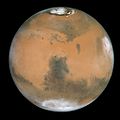File:Mars and Syrtis Major - GPN-2000-000923.jpg
外觀

預覽大小:600 × 600 像素。 其他解析度:240 × 240 像素 | 480 × 480 像素 | 1,023 × 1,023 像素。
原始檔案 (1,023 × 1,023 像素,檔案大小:104 KB,MIME 類型:image/jpeg)
檔案歷史
點選日期/時間以檢視該時間的檔案版本。
| 日期/時間 | 縮圖 | 尺寸 | 用戶 | 備註 | |
|---|---|---|---|---|---|
| 目前 | 2012年6月17日 (日) 22:57 |  | 1,023 × 1,023(104 KB) | Tomruen | {{Information |Description ={{en|1=Mars Near Opposition 1995-2005: 1999 }} |Source =Replace with 2005 release: http://hubblesite.org/newscenter/archive/releases/solar%20system/mars/2005/34/image/h/ |Author =NASA |Date =2005... |
| 2009年4月9日 (四) 00:52 |  | 800 × 800(227 KB) | BotMultichillT | {{Information |Description={{en|1=Taking advantage of Mars's closest approach to Earth in eight years, astronomers using NASA's Hubble Space Telescope have taken the space-based observatory's sharpest views yet of the Red Planet. The telescope's Wide Fi |
檔案用途
全域檔案使用狀況
以下其他 wiki 使用了這個檔案:
- ar.wikipedia.org 的使用狀況
- ca.wikipedia.org 的使用狀況
- en.wikipedia.org 的使用狀況
- Portal:Technology/Selected articles
- Portal:Technology/Selected articles/38
- History of Mars observation
- Portal:Outer space/Selected article
- Glossary of astronomy
- Portal:Outer space/Selected article/31
- Wikipedia:Today's featured article/January 2013
- Wikipedia:Today's featured article/January 8, 2013
- Wikipedia:Main Page history/2013 January 8
- es.wikipedia.org 的使用狀況
- fi.wikipedia.org 的使用狀況
- fr.wikipedia.org 的使用狀況
- he.wikipedia.org 的使用狀況
- id.wikipedia.org 的使用狀況
- ja.wikipedia.org 的使用狀況
- mwl.wikipedia.org 的使用狀況
- os.wikipedia.org 的使用狀況
- pt.wikipedia.org 的使用狀況
- ru.wikipedia.org 的使用狀況
- uk.wikipedia.org 的使用狀況
- ur.wikipedia.org 的使用狀況



